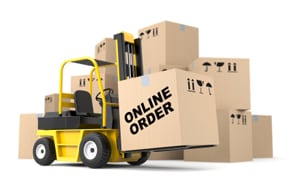 Online retailers are sprinting towards the day when they can offer consumers products at their convenience – anytime, anywhere and as quickly and affordable as possible. In 2014, we will see many big names, including Google, eBay and Amazon, continue to pour funding into delivery projects to bring this instant gratification to fruition.
Online retailers are sprinting towards the day when they can offer consumers products at their convenience – anytime, anywhere and as quickly and affordable as possible. In 2014, we will see many big names, including Google, eBay and Amazon, continue to pour funding into delivery projects to bring this instant gratification to fruition.
Here are some of the projects they might be looking into and a sampling of the top trends we can expect to see for package shipping in 2014.
Same-day Shipping Ramping Up
Like the California Gold Rush in the mid-1800s, companies far and wide are scrambling to San Francisco, among other large metropolitan areas, such as Manhattan and Queens, to test out same-day shipping programs. Services such as Metro Post, eBay Now, and Walmart To Go are capitalizing on San Francisco’s existing infrastructure to turn products around to local consumers the day they are ordered.
In 2014, plan to see more companies join the same-day shipping race by offering these services in more cities. These programs will likely find fans among errand-runners. Need to pick up groceries or a prescription, but don’t have time? That’s where same-day shipping will come in handy.
Receive All Packages Faster
While same-day shipping may not be required in all situations, expedited shipping requests are becoming increasingly common. Consumers want their packages to arrive before the excitement and novelty of their purchase wears off. Expect to see the standard delivery cycle shrink, enabling packages to arrive at their destination the very next day.
This shortened delivery cycle will result from an increase in product warehouses in metropolitan areas. Ecommerce companies will be looking to expand their physical presence so that they can run quicker delivery cycles efficiently.
Steering Away From Free Shipping
In 2013, we saw Amazon increase its free shipping minimum from $25 to $35. This move may, in part, aim to encourage Amazon Prime memberships, but it’s also a telltale sign of the costliness of free shipping.
It’s no secret that consumers love free shipping – in a survey conducted this past year by Endicia, consumers listed free shipping as the number one influencer behind an online purchase. But no matter how you slice it, moving things from one place to another costs money.
Up until now, companies have been willing to “take the hit,” covering shipping costs to ensure customers complete their online checkouts. But this year, we’ll see more companies following Amazon’s lead, opting for increased free shipping minimums or cost-effective creative strategies to entice customers.
Mobile Gets Better
We will see tablets and iPhones play a larger role in the shipping experience this year than last year.
Customers want to be able to track their packages at their convenience – in line at the grocery store or in the car picking up their kids from practice. Mobile sites will become increasingly easier-to-use to accommodate the vast majority of consumers tracking packages this way.
Lowering International Borders
Currently, few US merchants attempt international shipping due to complicated customs forms and regulations. We’re working with the US Postal Service and international post offices on new technology to lower the barriers of entry into the international shipping market.
With the advent of the Transatlantic Trade and Investment Partnership (TTIP) and other cross-border trade regulations, shippers will find it easier to bring their online business to new markets. Expect to see new international shipping options, improved shipping software and better package tracking.
Harry Whitehouse is the CTO and co-founder of Endicia.